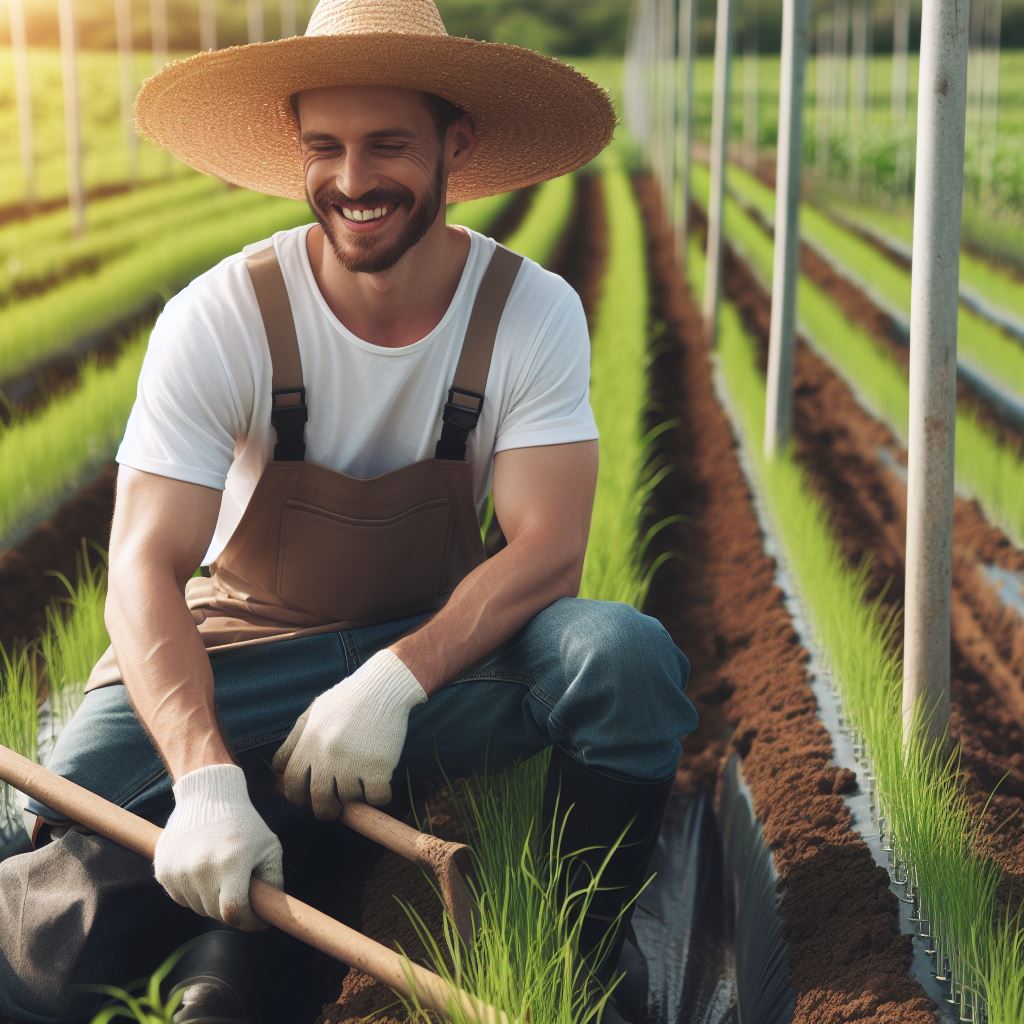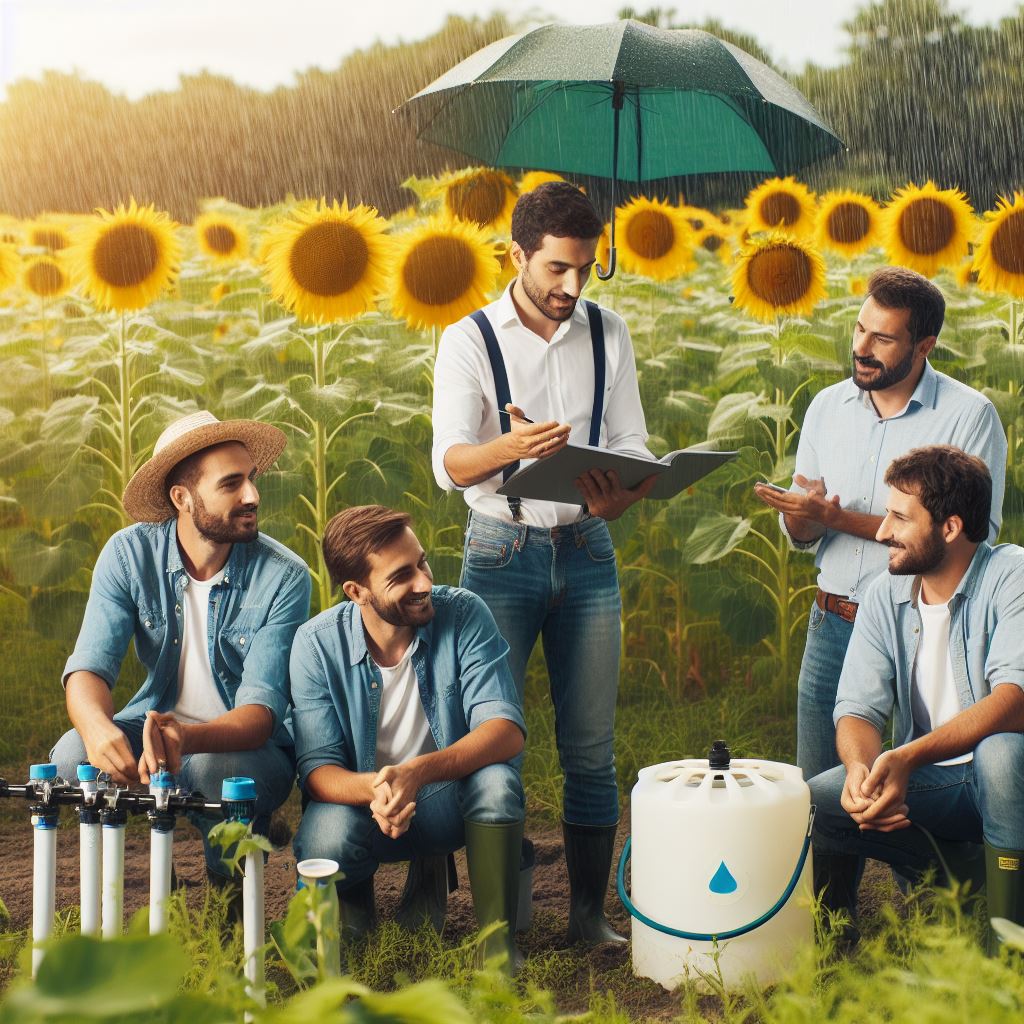Introduction
Irrigation is a fundamental aspect of agriculture, essential for crop growth and yield optimization. In many regions, rainfall alone cannot provide the required moisture levels for crops to thrive.
Hence, farmers resort to irrigation methods to supplement water needs, ensuring consistent growth and productivity.
Drip irrigation stands out as a modern and efficient technique employed by farmers worldwide.
Unlike traditional methods such as flood irrigation or sprinkler systems, drip irrigation delivers water precisely where it’s needed: at the plant roots.
This targeted approach minimizes water wastage and ensures optimal moisture levels for plant growth.
The concept of drip irrigation is relatively straightforward.
A network of tubes or pipes is installed throughout the field, with emitters strategically placed near each plant.
These emitters release water in small, controlled amounts directly onto the soil surface or directly into the root zone of the plants.
This method offers several advantages over conventional irrigation systems.
Firstly, drip irrigation conserves water by reducing evaporation and runoff, making it an environmentally friendly option.
Secondly, it promotes better plant health by providing consistent moisture levels, thereby reducing the risk of overwatering or underwatering.
Additionally, drip irrigation can improve crop yields and quality by delivering nutrients directly to the root zone, optimizing absorption.
Furthermore, drip irrigation is particularly beneficial for small-scale farmers with limited water resources.
By maximizing water efficiency, farmers can grow more crops with less water, increasing their overall productivity and profitability.
Moreover, the precise application of water and nutrients minimizes weed growth and soil erosion, contributing to sustainable farming practices.
Transform Your Agribusiness
Unlock your farm's potential with expert advice tailored to your needs. Get actionable steps that drive real results.
Get StartedIn recent years, technological advancements have further enhanced drip irrigation systems.
Smart irrigation controllers and sensors allow farmers to monitor soil moisture levels and adjust water delivery remotely, optimizing irrigation schedules and conserving resources.
Overall, drip irrigation represents a significant innovation in agricultural water management, offering a sustainable solution for small farms and large-scale operations alike.
As the world faces increasing water scarcity and climate variability, adopting drip irrigation can play a crucial role in ensuring food security and sustainable farming practices.
Benefits of Drip Irrigation for Small Farms
Drip irrigation offers several benefits that make it an innovative and effective solution for small farms.
In this section, we will explore the advantages of using drip irrigation systems, including water conservation, energy efficiency, and increased crop yield and quality.
Water conservation
Water conservation is a crucial aspect of sustainable farming practices.
- Reduced water wastage: With drip irrigation, small farms can substantially reduce water wastage.
- Efficient water delivery to plant roots: Drip irrigation delivers water directly to plant roots, minimizing evaporation and runoff, unlike traditional methods.
Energy efficiency
In addition to water conservation, drip irrigation also offers significant energy efficiency benefits for small farms.
- Lower pumping requirements: Compared to other irrigation techniques, such as overhead sprinklers or flood irrigation, drip systems require lower pumping requirements.
- Reduced energy costs: Using drip irrigation reduces energy consumption, leading to long-term cost savings for farmers.
Increased crop yield and quality
Furthermore, drip irrigation has been proven to increase crop yield and improve crop quality.
- Improved nutrient uptake: The controlled and precise delivery of water directly to the plant roots allows for better nutrient uptake, resulting in healthier and more productive crops.
- Enhanced control over soil moisture: Drip irrigation provides precise control over soil moisture levels, optimizing conditions for plant growth and minimizing water waste.
In a nutshell, the benefits of drip irrigation for small farms are numerous.
Water conservation, energy efficiency, and increased crop yield and quality are all valuable advantages that can contribute to the sustainability and profitability of small-scale agricultural operations.
By implementing innovative drip irrigation systems, small farmers can optimize their water usage, reduce energy costs, and achieve higher yields with better-quality crops.
Read: Vegetable Harvest Hints for Gardeners
Components of Drip Irrigation System
Drip irrigation has emerged as a game-changer for small-scale farmers, offering precise water delivery directly to plants’ roots.
Drip tape or tubing
- Drip tape, a thin plastic tube with evenly spaced emitters, ensures water reaches plants efficiently.
- Tubing serves as a flexible conduit, allowing for easy installation and customization to fit field layouts.
Emitters and drippers
- Emitters regulate water flow, ensuring each plant receives the required amount for optimal growth.
- Drippers, with varying flow rates, cater to different crop needs and soil conditions.
Filters and screens
- Filters and screens prevent clogging by removing debris, sediments, and organic matter from the water.
- Regular maintenance of filters ensures uninterrupted water flow and system longevity.
Pressure regulators and valves
- Pressure regulators maintain uniform pressure, preventing emitter clogging and ensuring even water distribution.
- Valves control the flow of water, allowing farmers to adjust irrigation schedules based on crop requirements.
Backflow preventer
- A backflow preventer safeguards against contamination, ensuring water safety for both crops and consumers.
- It is a critical component in maintaining the integrity of the irrigation system and adhering to safety standards.
Mainlines and sub-mainlines
- Mainlines distribute water from the source to different areas of the farm, ensuring efficient water supply.
- Sub-mainlines deliver water to individual crop rows, minimizing water waste and optimizing irrigation efficiency.
Implementing automation
- Automation, including smart controllers and sensors, enhances irrigation precision and efficiency.
- Smart controllers adjust irrigation schedules based on real-time weather data, soil moisture levels, and crop requirements.
In essence, the diverse range of components involved in a drip irrigation system allows farmers to take advantage of innovative technology to enhance their small farming operations.
Next, we will explore the benefits of implementing an automated drip irrigation system for small farms.
Read: Organic Pest Control Explained
Designing a Drip Irrigation System for Small Farms
For small farmers looking to implement a drip irrigation system, careful design considerations must be taken into account to maximize its effectiveness.
This section will delve into the various aspects of designing a drip irrigation system for small farms.
Determining water requirements
- Crop types and their water needs: Understanding crops’ varying water needs is essential. Leafy greens may need more water than root vegetables, requiring careful irrigation.
- Soil type and infiltration rate: Soil type affects irrigation schedules. Sandy soil drains faster than clay, requiring different watering adjustments.
Layout considerations
- Field size and shape: Field size and shape affect drip system layout. Farmers adjust pipe lengths, emitter placement, and zone numbers accordingly.
- Crop spacing and arrangement: Proper crop spacing affects irrigation design, ensuring efficient water distribution and preventing over or under-watering.
Calculating system capacity
- Water flow rate required: Farmers calculate crop water consumption to determine the required flow rate, ensuring the irrigation system meets water demands.
- Pressure requirements: Farmers consider crop type and land topography to select irrigation equipment suitable for the required water pressure.
Sizing mainlines and sub-mainlines
- Once the water requirements and pressure are known, farmers can calculate the appropriate sizes for the mainlines and sub-mainlines.
- These pipes distribute water from the water source to the plants efficiently.
Placing emitters for optimal coverage
- Proper emitter placement is essential to achieve uniform water distribution across the field.
- Farmers must take into account the specific water and spacing requirements of the crops to ensure optimal coverage.
In essence, designing a drip irrigation system for small farms requires careful consideration of water requirements, layout, system capacity, pipe sizing, and emitter placement.
By understanding these factors and implementing an efficient drip irrigation system, small farmers can enhance their crop yields while conserving water resources.
Drip irrigation offers a sustainable and innovative solution to help small farms thrive in an increasingly challenging agricultural landscape.
Read: Eco-Friendly Pest Control in Modern Farming

Installation and Maintenance Tips
Proper installation and regular maintenance of your drip irrigation system are essential for its efficiency and longevity.
Showcase Your Farming Business
Publish your professional farming services profile on our blog for a one-time fee of $200 and reach a dedicated audience of farmers and agribusiness owners.
Publish Your ProfileThe following guidelines will help you in the process:
Preparing the field for installation
- Clearing debris and leveling: Before installing the drip irrigation system, farmers must clear the field of debris and ensure proper leveling.
- Soil preparation and amendments: Before installation, farmers should till the soil and add necessary amendments like organic matter or fertilizers for improved soil quality.
Installing the system
- Laying mainlines and sub-mainlines: Start by laying the mainlines, connecting them to a water source, and distributing them evenly throughout the field. Then lay sub-mainlines.
- Placing emitters and drippers: Place emitters or drippers according to desired plant spacing, ensuring efficient water use and minimal evaporation. Secure them to prevent movement.
Regular maintenance practices
- Flushing and cleaning filters: Periodically flush the drip irrigation system to clear sediment and debris from filters. Clean filters to maintain optimal flow and pressure.
- Checking for leaks and blockages: Regularly monitor the system for leaks, checking connections, valves, and tubes. Clear blockages caused by mineral buildup or pests.
- System winterization: Before winter arrives, properly winterize your drip irrigation system to prevent damage from freezing temperatures. Drain all water.
By following these installation and maintenance tips, you can optimize the performance of your drip irrigation system and maximize water efficiency on your small farm.
Regular care and attention will help you achieve healthy and productive crops while conserving precious water resources.
Find Out More: Secrets to Perfect Crop Cultivation for High Yields
Cost Considerations and Return on Investment
Initial investment
- When implementing innovative drip irrigation, there are two primary cost considerations.
- The first is the equipment and materials required to set up the system.
- The second cost consideration is labor, including installation and maintenance.
Potential cost savings over time
- One of the key advantages of innovative drip irrigation is the potential for cost savings.
- Firstly, drip irrigation systems are known for their water and energy efficiency.
- This means reduced water bills and lower energy costs for pumping water.
- Secondly, drip irrigation can lead to increased crop yield and improved crop quality.
- With better water distribution and controlled delivery, plants receive the necessary nutrients and moisture.
Calculating the return on investment (ROI)
- When considering any investment, it’s important to calculate the potential return.
- The payback period is one way to assess the financial viability of implementing drip irrigation.
- This period represents the time it takes to recoup the initial investment through cost savings.
- Long-term benefits should also be taken into account when calculating the ROI.
- These benefits include improved crop health, higher market value, and reduced water usage.
Basically, despite the initial costs, innovative drip irrigation offers substantial cost savings and return on investment for small farms.
The efficient use of water and energy, coupled with increased crop yield and quality, can offset the initial investment over time.
Additionally, the long-term benefits of improved crop health and environmental sustainability make drip irrigation an attractive option for farmers looking to optimize their operations.
Find Out More: Agroforestry: Combining Crops and Trees
Case Studies of Successful Drip Irrigation Implementation on Small Farms
Drip irrigation has proven to be a game-changer for small farms, offering various benefits such as increased yield, water savings, improved crop quality, and enhanced control over soil moisture.
In this section, we will explore two successful case studies of small farms that have implemented innovative drip irrigation systems and achieved remarkable results.
Nash’s Organic Farm – Vegetable production
One such case study is Nash’s Organic Farm, which specializes in vegetable production.
- Increased yield and water savings: Incorporating drip irrigation increased yield and saved water on this farm. Precisely applying water minimizes waste and maximizes efficiency.
- Improved crop quality: Drip irrigation reduced water use and improved crop quality. Controlled moisture levels led to healthier plants and better vegetables.
Windrose Farm – Orchard cultivation
Another farm that has experienced the benefits of drip irrigation is Windrose Farm, which primarily focuses on orchard cultivation.
- Enhanced control over soil moisture: Windrose Farm uses drip irrigation to control soil moisture levels, preventing over or under-watering and maintaining plant health.
- Optimized nutrient delivery: Furthermore, drip irrigation optimizes nutrient delivery to orchard crops, ensuring constant supply for healthier growth and maximum productivity.
In summary, drip irrigation has revolutionized small-scale farming by providing precise water application, water savings, improved crop quality, and enhanced control over soil moisture.
Nash’s Organic Farm and Windrose Farm serve as excellent case studies, showcasing the numerous benefits of drip irrigation in both vegetable production and orchard cultivation.
By adopting this innovative irrigation system, small farms can optimize their resources, increase productivity, and contribute to a more sustainable agricultural future.
Read: Resilient Crops: Adapting to New Climates
See Related Content: Effective IPM for Common Crop Pests
Conclusion
Implementing innovative drip irrigation systems offers several benefits for small farms. Firstly, it allows efficient water usage, reducing water wastage significantly.
Secondly, it minimizes weed growth, as the water is delivered directly to the roots of the plants.
Thirdly, it enables farmers to have precise control over the timing and amount of water delivered, resulting in healthier and more productive crops.
If you own a small farm, it is highly recommended to explore and implement drip irrigation systems.
This method not only promotes water conservation but also increases crop yield and reduces manual labor.
By automating the irrigation process, you can allocate more time and resources to other aspects of farming, such as marketing and expansion.
Therefore, innovative drip irrigation has the potential to transform small-scale agriculture.
By revolutionizing the way water is utilized, it optimizes crop growth and resource management, leading to sustainable farming practices.
As more farmers embrace this technology, we can expect to see significant advancements in small farm productivity and profitability.




